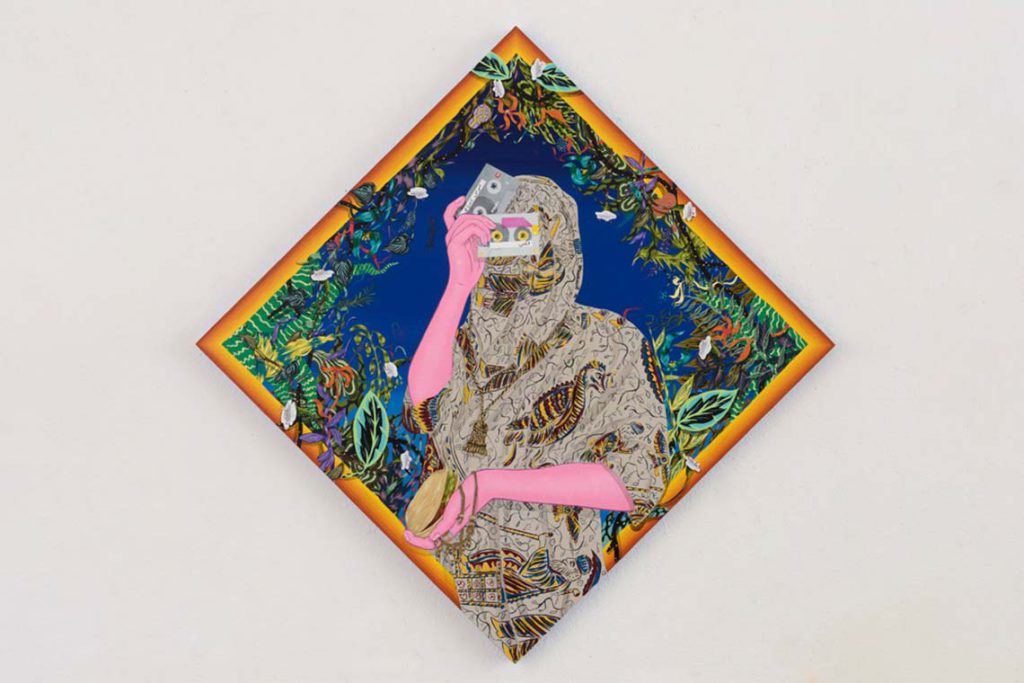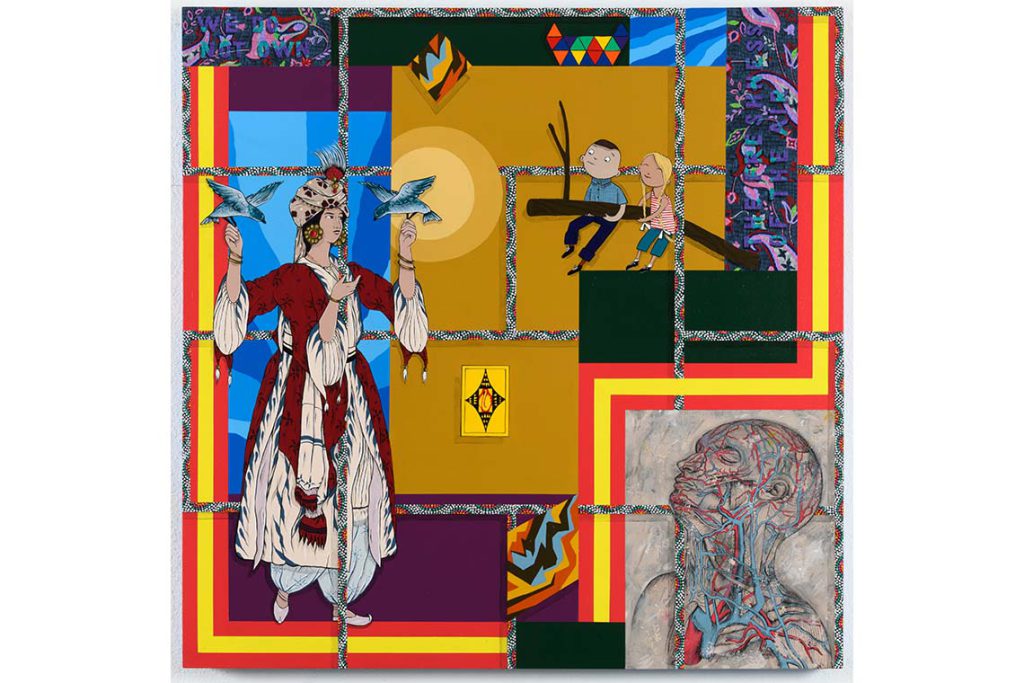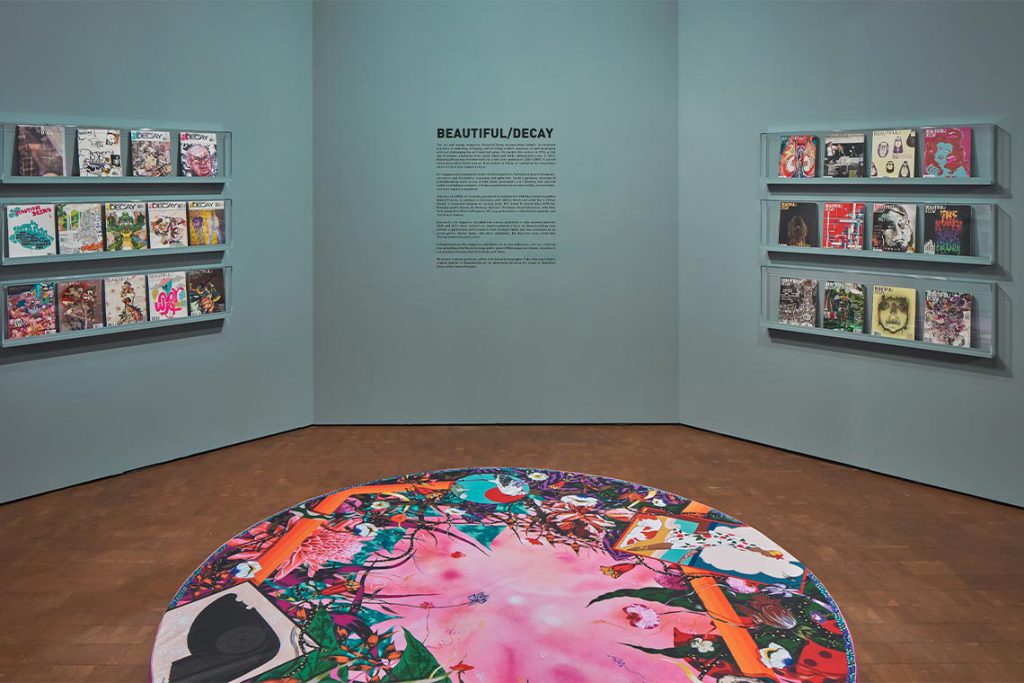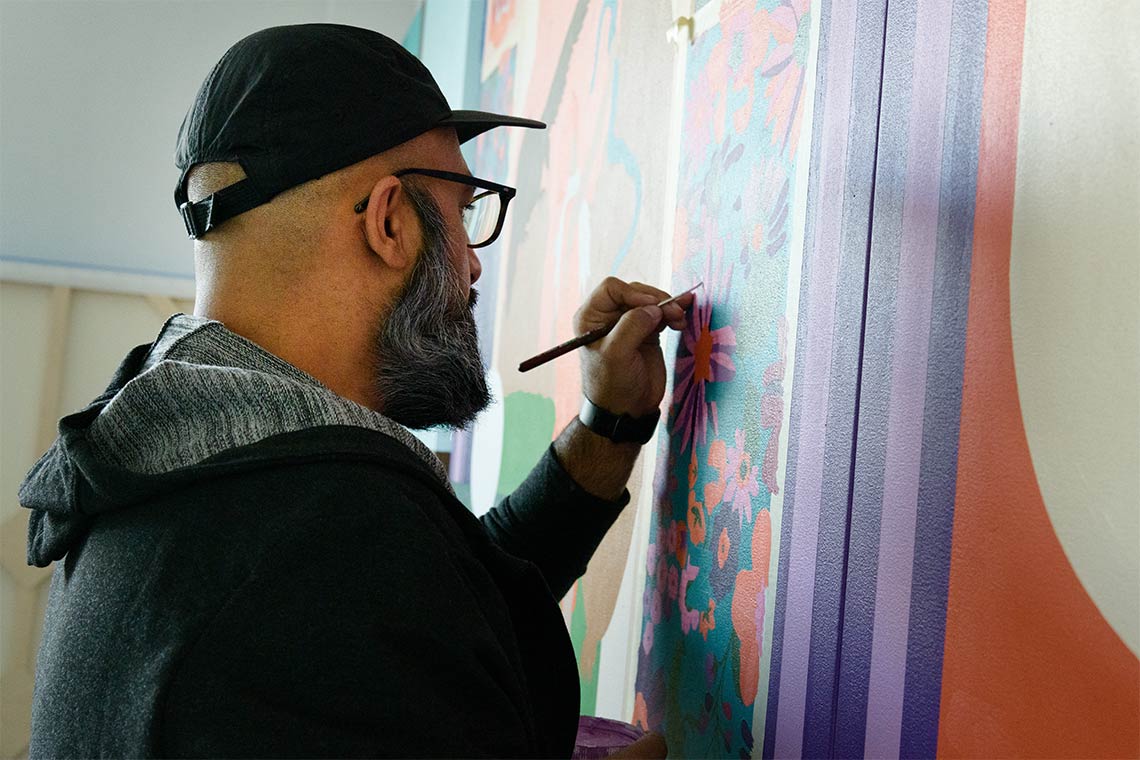In full embrace of its maximalism, Amir H Fallah’s work springs from his backgrounds in skateboarding, graffiti, running a subversive culture publication and his departure from and love for Iran.
To Iranian-American, Los Angeles-based contemporary artist Amir H Fallah, art felt like skateboarding when he was young. “It was a completely independent pursuit. You could do it anywhere and you didn’t need to be on a team,” he shares. Enthralled by the bold, bright graphics of skateboard decks, Fallah began his art practice at the mere age of 12. Now at 44 – a BFA from Maryland Institute College of Art (2001) and an MFA from University of California, Los Angeles (2005) later – this has blossomed into an abundant career that spans paintings, sculpture, public art, photography, installation and NFTs. “I spend months working quietly in the studio,” he continues. “I love that it all comes out of me and I can make my own rules.” Just like a skateboarder improvising his path.
Fallah was born in Tehran in 1979, at the height of the Iranian Revolution. The Iran-Iraq War broke out just a year later. By the time he was four, Fallah’s family had left, eventually coming to settle in the USA when he was seven. When one’s first years of existence are marked by such upending of normalcy, a natural desire to construct newer, alternative logics – beyond states and borders – can arise, those that accommodate hybridity as the new normal. Leaving one’s homeland, becoming a refugee, immigrating, then entering a condition of indefinite diaspora can certainly produce a state of excess – of emotion, contradictions, stimulations, identities jostling for attention. Hybridity, inherently, is excessive. Instead of shrinking back, Fallah’s practice leans into this, embracing maximalism as a method. His work splices together his Iranian and American worlds, fusing them into something new – Western graphics, cartoons and comics meld with Persian miniatures, motifs and iconography. Works likeA Distorted Reality is Now A Necessity To Be Free(2019), We Do Not Own the Freshness in the Air(2021) and Build Borderless Worlds(2021) – apart from being lyrically yet politically named – almost look quilted, a patchwork of places, images and stories from a stew of different origins. They’re collage-like, cut, pasted and remixed like a chopped and screwed track to produce an entirely different song.

76 x 76 cm. Image courtesy of the artist and The Third Line, Dubai
When Fallah was a high-school teenager in 1996, he co-founded Beautiful/Decay with Jay Littleton, a pre-Internet DIY zine comprising all kinds of interdisciplinary artwork, essays, interviews and more, by an assortment of fashion and graphic designers, musicians, artists, gallerists, animators and illustrators. “Beautiful/Decay was a crucial turning point in my art practice,” Fallah explains, one that birthed many of the themes that continue to manifest in his work. “More than just a magazine, [it] was itself an artwork and in many ways an extension of my studio practice,” he adds. “Whether it’s digging through archives, incorporating principles of design, or challenging the arbitrary lines between highbrow and lowbrow, Beautiful/Decay represents an integral part of my foundation as an artist.” By 2001, the black-and-white photocopied zine had developed into an established colour magazine, going on to publish 26 issues over the next eight years, before transitioning to bound books until 2013 when it shifted to the digital blogosphere. Even amid growth and change, the publication maintained a steadfast commitment to “dissolving boundaries” and honouring subcultures, a clear originary influence of Fallah’s adolescent milieu of skateboarding and graffiti.

Image courtesy of the artist
Many of the ways in which Fallah put together issues of Beautiful/Decayinform his methods now. When building a work, he pulls images from a variety of places, ranging from online databases to digitised archives and libraries and social media, quite like producing an editorial mock-up. After the collection comes the fitting together, subverting the expected, unspoken boundaries for how and where we think certain images should be placed and shown, especially those from disparate cultures, categories and sources. For instance, in The Clouds in my Eyes are Filled with Dew(2017), a veiled figure with pink skin, framed by an electric-blue background filled with tropical plants, holds a giant pistachio in one hand and a pair of mixtapes in the other to cover their gaze. It’s weird, yet warm. Moreover, although Beautiful/Decay preceded the Internet, its form predisposed Fallah to respond very favourably to the recent rise in digital art and NFTs. He minted his first NFT, titled Immortal, in early 2021. “The digital space is as much a medium as any ‘traditional’ technique,” he affirms. “I think NFTs offer a great opportunity to explore…while also confronting the ever-shifting landscape of creative production in the unprecedented and unpredictable post-Information Age.”
For Fallah’s first institutional solo exhibition in Los Angeles, The Fallacy of Borders, currently on show at UCLA’s Fowler Museum, curator Amy Landau chose to open the exhibition with an archive of Beautiful/Decay, its first time being exhibited. It’s a nod to the visual language that Fallah has constructed for himself through this publication, a language that he has expanded into newer media like NFTs, but also stained glass and abstract sculptures that do not depict any gender, ethnicity or class, thereby eschewing these categories as constructs altogether. These figures are therefore free in a way no other body can be in this world – borderless, curiously, like the capacities of the Internet.

Photography by Elon Schoenholz. Image courtesy of Fowler Museum
Fallah’s gallery representation is as expansive as some of his canvases, including The Third Line in Dubai, Dio Horia Gallery in Athens and Shulamit Nazarian in Los Angeles. In 2009, he participated in the ninth Sharjah Biennial and he has had solo shows at the Museum of Contemporary Art in Tucson, the South Dakota Art Museum and the San Diego ICA, among others. He has also won a number of prestigious accolades, such as the 2015 Joan Mitchell Foundation Painters and Sculptors Grant and the 2020 COLA Individual Artist Fellowship. 2023 has proved a mammoth year already, with the current show at Fowler, another solo show at Shulamit Nazarian and a solo booth at Art Basel Hong Kong. Now, Fallah is looking to slow down, preparing for an exhibition at Gallery All in Shanghai and other public art projects. Although the crux, that language at the core of his practice, continues in the same vein.
“Whether it’s in the use of botanical imagery as a metaphor for migration, juxtaposing references across cultures and historical eras, or challenging traditional notions of portraiture, I am constantly confronting assumptions about identity through this lens of immigration,” Fallah says. In this way, his works become alternative blueprints for social processing and rethinking not only for himself, but also for his half-Iranian, half-Puerto Rican son who has never seen Iran, as well as other members of the Iranian diaspora, of which LA has the biggest number. Despite being based in the USA for most of his life now, the “uncertain nature” of Fallah’s identity still holds its heart in Iran. In February this year, he unveiled a public artwork named Chant(2023), consisting of a neon sun with female features and the slogan “Woman, Life, Freedom” surrounding it in English and Farsi. It’s a tribute to the revolution – not the one Fallah left behind, but the one occurring in Iran right now, sparked by the death of 22-year-old Mahsa Amini at the hands of the morality police. “I plan on creating more public artworks of this nature,” Fallah states. “The movement is far from over.” As history continues into the present, an artist like Fallah remixes it so we may find something new in the debris.
This profile first appeared in Canvas 108: The Root of it All



